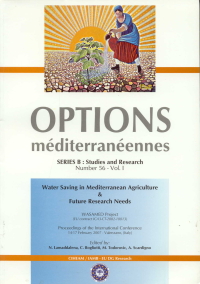| Article précédent | p. 121-141 | Article suivant |
Spatial simulation of water use efficiency in a Mediterranean environment
Simulation models are often used to verify the potentiality of crop management, allowing multi-year and multi-location runs with minimum time spending. In Southern Italy, where water-limited conditions are frequent, is important to identify crop management which allows better the transformation of water (and irrigation water) in commercial yield. In this research a spatial analysis of a long-term simulation was carried out with AEGIS/WIN, a Geographic Information Systems (GIS) interface of DSSAT crop simulation package. The case-study is referred to a 1000 km2 area (Foggia, Southern Italy), characterized by 481 soil samples collected at a regular grid. Durum wheat and processing tomato have been simulated punctual-based using soil and long-term weather data (45 years). The two crops have been compared in the following management scenarios: rainfed and three automatic irrigation levels based on soil water content thresholds. Average and standard deviation of commercial yield (grain and fruit), seasonal evapotranspiration and irrigation amount were evaluated as model output. Water use efficiency (WUE) and irrigation water use efficiency (IRWUE) were then calculated. All the above variables were visualised and mapped with GIS. The wheat productivity was increased by irrigation of 19 percent and no difference occurred among automatic irrigation thresholds. WUE resulted similar in the 4 irrigation scenarios, while the southern part of the plain showed the higher IRWUE. In tomato the irrigation increased 3 times the yield respect to rainfed, with no difference among irrigation scenarios. WUE did not differ spatially, while IRWUE was higher in the southern part. Climatic conditions (rainfall and temperature) and soil water holding capability resulted the variables that more influenced the above use efficiencies, especially for tomato crop.
Dans cette recherche on a effectué l'analyse spatiale d'une simulation à long terme avec AEGIS/WIN, un système d'information géographique (GIS, Geographic Information Systems) interface du modèle de simulation cultural DSSAT. L'étude de cas fait référence à un secteur de 1000 km2 situé à Foggia, en Italie méridionale, où 481 échantillons de sol ont été prélevés selon un quadrillage régulier. Le blé dur et la tomate de transformation ont fait l'objet d'une simulation basée sur l'utilisation ponctuelle du sol et sur les données météorologiques à long terme (45 ans). Les deux cultures ont été comparées selon différents scénarios : absence d'irrigation (pluie uniquement) et trois niveaux d'irrigation automatique basés sur les seuils d'humidité du sol. La moyenne et l'écart type des rendements commerciaux (grain et fruit), l'évapotranspiration saisonnière et la quantité d'irrigation ont été évalués comme output du modèle. L'efficacité de l'utilisation de l'eau (WUE) et de celle de l'eau d'irrigation (IRWUE) ont été ensuite calculées. Toutes les variables décrites précédemment ont été visualisées et cartographiées avec le GIS. L'irrigation a augmenté de 19 pour cent la productivité du blé, quels que soient les trois seuils d'irrigation automatique pratiqués. L'efficacité de l'utilisation de l'eau est la même pour les 4 scenarios tandis que la zone située plus au sud de la plaine a montré une plus haute efficacité de l'utilisation de l'eau d'irrigation. Pour la tomate, l'irrigation a permis de tripler le rendement par rapport à la tomate non irriguée, indifféremment des 3 scenarios d'irrigation possibles. La WUE ne diffère pas dans l'espace contrairement à la IRWUE. Les conditions climatiques et la capacité de rétention hydrique du sol sont les variables qui ont le plus influencé l'efficacité de l'utilisation de l'eau surtout pour la culture de la tomate.
- [ Afficher ]
- [ Télécharger ]
- [ Exporter la citation ]
Vous pouvez télécharger la citation au format :
- [ Imprimer ]
-
Mots-clés
EFFICACITE, IRRIGATION, ITALIE, LYCOPERSICON ESCULENTUM, MODELE DE SIMULATION, SYSTEME D'INFORMATION GEOGRAPHIQUE, TRITICUM DURUM, UTILISATION DE L'EAUCiter cet article
Rinaldi M., Ubaldo R. Spatial simulation of water use efficiency in a Mediterranean environment. In : Lamaddalena N. (ed.), Bogliotti C. (ed.), Todorovic M. (ed.), Scardigno A. (ed.). Water saving in Mediterranean agriculture and future research needs [Vol. 1]. Bari : CIHEAM, 2007. p. 121-141. (Options Méditerranéennes : Série B. Etudes et Recherches; n. 56 Vol.I). Proceedings of the International Conference WASAMED Project (EU contract ICA3-CT-2002-10013), 2007/02/14-17, Valenzano (Italy). http://om.ciheam.org/om/pdf/b56_1/00800107.pdf



